Making  a habit of winning awards, and for almost everything under the sun – putting together the Travel + Leisure Award, the Condé Nast Awards, the Gallivanter’s Guide Awards for Excellence, the National Geographic Traveler (China) Gold List only to name a few, the Peninsula Bangkok stands proud as one of the finest hotels in Bangkok.
a habit of winning awards, and for almost everything under the sun – putting together the Travel + Leisure Award, the Condé Nast Awards, the Gallivanter’s Guide Awards for Excellence, the National Geographic Traveler (China) Gold List only to name a few, the Peninsula Bangkok stands proud as one of the finest hotels in Bangkok.
THE VIEW: Built on the western bank of the scenic Chao Phraya River, the distinct and unique wave- shaped design of the hotel offers a window to the picturesque cityscape. An unobstructed view of the glistening river, from every corner of the hotel (including the rooms) adds an inimitable style quotient to scenic Bangkok.
shaped design of the hotel offers a window to the picturesque cityscape. An unobstructed view of the glistening river, from every corner of the hotel (including the rooms) adds an inimitable style quotient to scenic Bangkok.
ARCHI TYPE: The 39-storey structure has 370 guest room suites (some of the largest in the city). Apart from facing the river, the ten guest rooms and two one– bedroom suites on each of the floors, are replete with state-of the- art amenities and are also decorated to absolute perfection!
bedroom suites on each of the floors, are replete with state-of the- art amenities and are also decorated to absolute perfection!
BON APPÉTIT: A variety of options are available for dining at the Peninsula Bangkok. From elaborate and scrumptious Cantonese cuisine at Mei Jiang, to the Pacific Rim cuisine in a more contemporary riverview setting at Jesters; the elegant and home styled Thai dining at Teak Pavilions by the river at Thiptara, the Lobby for light meals, the River Cafe & Terrace with open kitchens and the Pool Bar is ideal for unwinding.
AROUND THE CORNER: Standing tall in the heart of the city, the Peninsula Bangkok is in close proximity to major tourist attractions. The Grand Palace, the Temple of Dawn, the Reclining Buddha, the Golden Buddha, the famous flower market and Chinatown are all not very far away.
Standing tall in the heart of the city, the Peninsula Bangkok is in close proximity to major tourist attractions. The Grand Palace, the Temple of Dawn, the Reclining Buddha, the Golden Buddha, the famous flower market and Chinatown are all not very far away.
FROM UNDER THE CARPET: Know a little about the language and the phonetics… lest you’re left tongue-tied!
IN ESSENCE: The perfect Thai flavour that’ll last a lifetime!
 a habit of winning awards, and for almost everything under the sun – putting together the Travel + Leisure Award, the Condé Nast Awards, the Gallivanter’s Guide Awards for Excellence, the National Geographic Traveler (China) Gold List only to name a few, the Peninsula Bangkok stands proud as one of the finest hotels in Bangkok.
a habit of winning awards, and for almost everything under the sun – putting together the Travel + Leisure Award, the Condé Nast Awards, the Gallivanter’s Guide Awards for Excellence, the National Geographic Traveler (China) Gold List only to name a few, the Peninsula Bangkok stands proud as one of the finest hotels in Bangkok.THE VIEW: Built on the western bank of the scenic Chao Phraya River, the distinct and unique wave-
 shaped design of the hotel offers a window to the picturesque cityscape. An unobstructed view of the glistening river, from every corner of the hotel (including the rooms) adds an inimitable style quotient to scenic Bangkok.
shaped design of the hotel offers a window to the picturesque cityscape. An unobstructed view of the glistening river, from every corner of the hotel (including the rooms) adds an inimitable style quotient to scenic Bangkok.ARCHI TYPE: The 39-storey structure has 370 guest room suites (some of the largest in the city). Apart from facing the river, the ten guest rooms and two one–
 bedroom suites on each of the floors, are replete with state-of the- art amenities and are also decorated to absolute perfection!
bedroom suites on each of the floors, are replete with state-of the- art amenities and are also decorated to absolute perfection!BON APPÉTIT: A variety of options are available for dining at the Peninsula Bangkok. From elaborate and scrumptious Cantonese cuisine at Mei Jiang, to the Pacific Rim cuisine in a more contemporary riverview setting at Jesters; the elegant and home styled Thai dining at Teak Pavilions by the river at Thiptara, the Lobby for light meals, the River Cafe & Terrace with open kitchens and the Pool Bar is ideal for unwinding.
AROUND THE CORNER:
 Standing tall in the heart of the city, the Peninsula Bangkok is in close proximity to major tourist attractions. The Grand Palace, the Temple of Dawn, the Reclining Buddha, the Golden Buddha, the famous flower market and Chinatown are all not very far away.
Standing tall in the heart of the city, the Peninsula Bangkok is in close proximity to major tourist attractions. The Grand Palace, the Temple of Dawn, the Reclining Buddha, the Golden Buddha, the famous flower market and Chinatown are all not very far away.FROM UNDER THE CARPET: Know a little about the language and the phonetics… lest you’re left tongue-tied!
IN ESSENCE: The perfect Thai flavour that’ll last a lifetime!
For Complete IIPM Article, Click here
Source: IIPM Editorial, 2008
An IIPM and Management Guru Prof. Arindam Chaudhuri's Initiative
Source: IIPM Editorial, 2008
An IIPM and Management Guru Prof. Arindam Chaudhuri's Initiative


